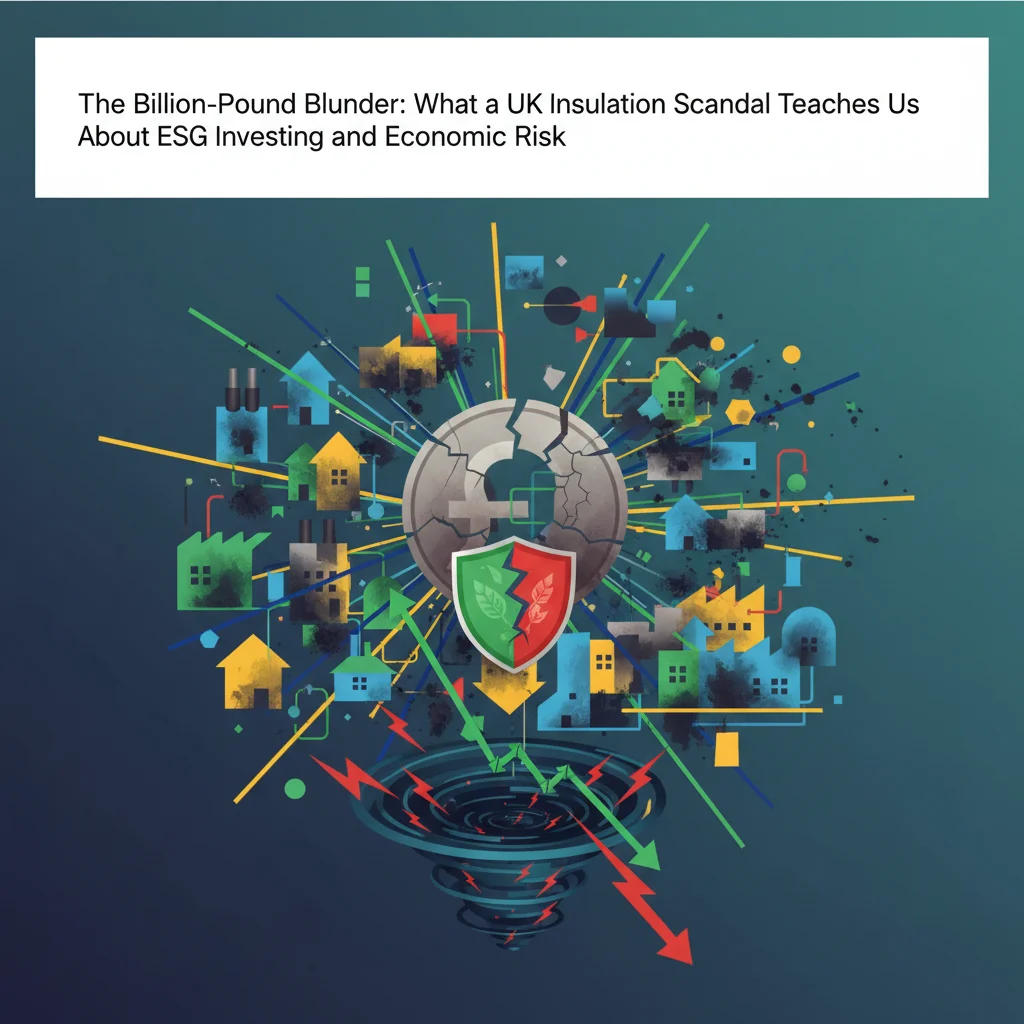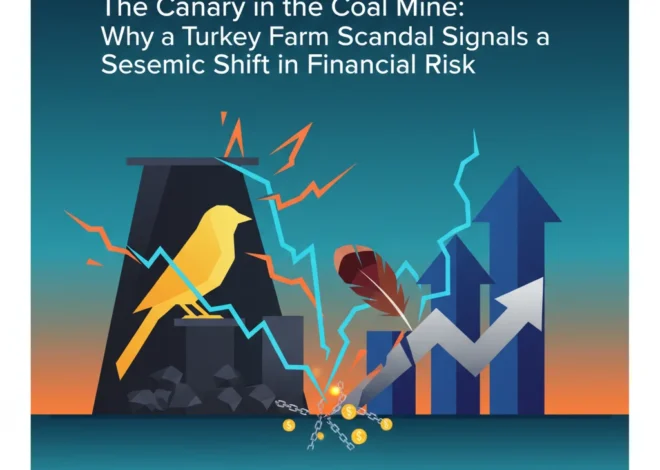
The Billion-Pound Blunder: What a UK Insulation Scandal Teaches Us About ESG Investing and Economic Risk
The Unseen Costs of “Going Green”
In the global push towards a sustainable future, governments and investors have poured trillions into green initiatives. The logic seems unassailable: invest in environmentally friendly projects, stimulate the economy, and save the planet. But what happens when good intentions collide with poor execution? A recent scandal emerging from the United Kingdom offers a sobering answer. A multi-billion-pound government programme designed to make homes more energy-efficient has backfired spectacularly, leaving tens of thousands of homes riddled with damp and mould due to botched insulation installations. This isn’t just a construction issue; it’s a cautionary tale for investors, a case study in public policy failure, and a stark reminder of the immense operational risks lurking within the booming ESG (Environmental, Social, and Governance) market.
The initiative, which cost billions in public funds, was meant to be a win-win: homeowners would get lower energy bills, and the country would move closer to its carbon reduction targets. Instead, it has morphed into a financial and public health nightmare. For business leaders, finance professionals, and anyone involved in the capital allocation that underpins our economic future, this story offers critical lessons in due diligence, the perils of subsidized markets, and the urgent need for technological oversight in large-scale projects.
Anatomy of a Financial Catastrophe
At its core, the failure stemmed from a breakdown in quality control. The government schemes, aimed at insulating homes to conserve heat, inadvertently created a gold rush for contractors. The immense pressure to meet targets, coupled with insufficient oversight, led to widespread poor-quality work. Installers, some inadequately trained, fitted insulation incorrectly, blocking necessary ventilation and trapping moisture within walls. The result? A slow-brewing disaster of condensation, dampness, and toxic mould, turning dream eco-homes into health hazards.
The financial implications are staggering and multifaceted. Let’s break down the economic fallout for each group of stakeholders.
The table below illustrates the stark contrast between the intended benefits of the insulation programmes and the disastrous reality, highlighting the financial burden placed on various sectors of the economy.
| Stakeholder | Intended Economic Outcome | Actual Financial Impact |
|---|---|---|
| Homeowners | Reduced energy bills, increased property value, and improved living standards. | Significant repair costs for damp and mould, decreased property value, potential health-related expenses, and higher-than-expected energy bills due to ineffective insulation. |
| Taxpayers & Government | Efficient use of public funds to meet climate goals and stimulate the green economy. | Billions of pounds in public finance wasted on a failed programme, plus the future costs of remediation, potential legal liabilities, and reputational damage. |
| The Green Industry | Growth in jobs, enhanced market reputation, and a stable pipeline of work. | Severe damage to consumer trust, potential for stricter (and more costly) regulation, and a negative halo effect on reputable firms in the sector. |
| The Broader Economy | A step towards energy independence and a greener GDP. | Misallocation of capital, a drag on the housing market in affected areas, and a lesson in the economic inefficiency of poorly managed government subsidies. |
The watchdog group that uncovered the scale of the problem warns that fixing these homes will require a massive, coordinated effort, representing another layer of cost built on top of the initial wasted investment. This is a classic example of long-tail risk—where the true cost of a bad investment only becomes apparent years after the initial capital has been spent.
A Sobering Lesson for ESG Investors
For the investment community, this is more than a piece of news; it’s a critical case study. The global ESG market is booming, with trillions of dollars flowing into funds that promise both financial returns and positive environmental impact. This insulation scandal serves as a potent warning against “greenwashing” and the dangers of prioritizing optics over operational excellence.
Investors focused on the stock market must learn to look beyond a company’s glossy sustainability report. Key questions to ask include:
- Execution Capability: Does the company or entity have a proven track record of delivering complex projects on the ground? A great green idea is worthless without the ability to execute it flawlessly.
– Supply Chain Integrity: What checks and balances are in place to ensure quality and accountability from all contractors and suppliers?
– Incentive Structures: Are the financial incentives designed to reward quality and long-term success, or do they encourage cutting corners to meet short-term targets?
This incident demonstrates that a government contract or a “green” label is not a guarantee of quality or a safe investment. The companies involved in this scheme, and by extension their investors, are now facing reputational damage and potential liabilities. It shows how operational risk in an ESG-focused project can quickly become a material financial risk, impacting everything from stock price to credit ratings. The principles of fundamental analysis and rigorous due diligence, long the bedrock of sound investing, are more important than ever in the age of green finance.
Can Technology Prevent the Next Billion-Pound Blunder?
While the problem is rooted in human error and flawed policy, the solution may lie in technology. This is where the worlds of construction, public finance, and cutting-edge financial technology intersect. How could we build a system that ensures transparency and accountability in such large-scale initiatives? The answer may involve two transformative technologies: Fintech and Blockchain.
Imagine a future where every stage of a government-funded insulation project is tracked on an immutable ledger. This is the promise of blockchain technology.
- Installer Verification: A contractor’s credentials, certifications, and past performance reviews could be stored as a non-fungible token (NFT) on a blockchain, making it impossible to falsify qualifications.
– Material Provenance: The origin and quality certification of all insulation materials could be tracked from the factory to the installation site, ensuring substandard products are never used.
– Proof of Work: An installer could be required to upload time-stamped photos and sensor data (e.g., thermal readings) at key stages of the installation process, creating a permanent, verifiable record of the work completed to standard.
This transparent ledger could then be integrated with Fintech payment systems. Instead of traditional invoicing, payments could be automated through smart contracts. A smart contract is a self-executing contract with the terms of the agreement directly written into code. In this scenario, the government’s banking and payment system would only release funds to a contractor when specific, verifiable conditions are met on the blockchain—for example, once a certified, independent inspector digitally signs off on the completed work. This eliminates the possibility of paying for botched jobs and aligns financial incentives directly with quality outcomes. This isn’t science fiction; it’s the application of existing financial technology to solve a real-world problem of immense economic scale.
Actionable Takeaways for Leaders and Policymakers
The UK insulation scandal is a multi-layered failure that offers clear, actionable lessons for anyone in a position of leadership, whether in government or the private sector.
- Prioritize Quality Over Quantity: The obsession with hitting arbitrary installation targets led directly to the collapse in quality. Future schemes must build in robust, independent quality assurance at every step, even if it means slower deployment. The long-term economic cost of remediation far outweighs the short-term benefit of hitting a target.
- Align Incentives with Long-Term Outcomes: The payment structures for contractors must be re-engineered. Consider models that include a warranty period, where a portion of the payment is held in escrow and released only after a year to ensure no issues like damp or mould arise. This forces contractors to have skin in the game.
- Embrace Technological Oversight: As outlined above, leveraging fintech and blockchain for project management, verification, and payment processing is no longer a futuristic luxury but a present-day necessity for managing large-scale public investments. The cost of implementing such a system is a fraction of the billions lost to this failed programme.
- Rethink the Economics of Subsidies: This failure highlights the inherent market distortions created by large government subsidies. It can create perverse incentives and attract bad actors. A robust framework of checks, balances, and market-based accountability is essential for any public-private partnership.
Ultimately, the path to a sustainable future is paved not just with good intentions, but with rigorous execution, sound economics, and intelligent governance. The UK’s insulation blunder is a painful but invaluable lesson. It teaches us that the “E” in ESG is meaningless without excellence in execution, and that the biggest risk in the green transition may not be a lack of capital, but a failure of competence. For investors, policymakers, and business leaders, the message is clear: the devil is in the details, and ignoring them can lead to a billion-pound disaster.


